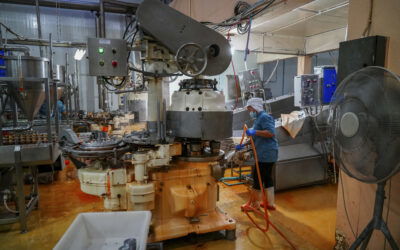Industrial quality plays a central role in the world of modern industry. It aims to ensure that products and services meet customer requirements, while ensuring compliance with regulatory standards. This approach is not limited to controlling production processes, but also encompasses risk management, safety and continuous improvement. This article explores the principles, tools and practices that shape industrial quality today.
Introduction to industrial quality
What is quality in industry?
In the industrial sector, quality refers to the ability of a product or service to meet customer expectations while complying with regulatory requirements. It encompasses technical, safety and performance aspects. Industrial quality is based on methods and tools designed to guarantee product conformity and the efficiency of production processes.
The importance and challenges of industrial quality
Quality is crucial to maintaining an industrial company’s competitiveness. A well-structured quality approach helps minimize defects, improve customer satisfaction and control safety risks. What’s more, it promotes organizational efficiency, reduces the cost of non-conformance and compliance with environmental standards, while ensuring continuous process improvement.
The fundamentals of industrial quality
The 4 types of quality and their implications
The four types of quality are product quality, process quality, service quality and environmental quality. Each plays a fundamental role in satisfying customer requirements and ensuring regulatory compliance. By optimizing these dimensions, companies can better control production, improve performance and reduce risk.
The 4 pillars of industrial quality
The four pillars of industrial quality are control, continuous improvement, risk management and compliance with standards. Together, they form the basis of quality initiatives, ensuring the robustness of processes and the satisfaction of stakeholders. Implementing these pillars is essential to guarantee long-term industrial performance.
History and evolution of the quality approach in industry
The quality approach in industry has evolved over time, from simple product control to an integrated quality management system. The concept of Total Quality Management (TQM) emerged in the 20th century, emphasizing the participation of all teams and the responsibility of engineers in the continuous improvement of production processes and services.
Industrial quality standards and certifications
ISO 9001 standardization and certification
ISO 9001 is an international framework for quality management. It is designed to help companies organize their processes, improve customer satisfaction and guarantee product and service conformity. ISO 9001-certified companies benefit from recognition of their quality approach, which enhances their competitiveness in the marketplace.
Quality assurance and total quality management (TQM)
Quality assurance aims to ensure that production processes are under control and that products meet quality requirements. Total Quality Management (TQM) is based on the involvement of all employees in continuous improvement. This method enhances customer satisfaction and improves overall company performance, while limiting the risk of non-conformity.
Implications of quality for safety and regulatory compliance
Industrial quality is closely linked to safety and regulatory compliance. Quality standards ensure that products and services comply with legal requirements, thereby reducing risks to consumers and the environment. Rigorous process management helps prevent accidents and non-conformities, and ensures the safety of workers in the workplace.
Tools and methods for maintaining quality
In industry, effective methods for maintaining quality are essential. Industrial companies use a variety of tools and techniques to control production, guarantee product conformity and improve processes. These methods not only minimize defects, but also optimize overall performance. The aim is to enhance customer satisfaction while ensuring the safety and sustainability of operations.
What are the 7 quality tools?
The 7 quality tools are indispensable methods in industrial quality management: Pareto charts, cause-effect diagrams, histograms, control charts, scatter diagrams, control graphs and fishbone diagrams. These tools make it easier to visualize problems and identify areas for improvement within production processes.
Lean manufacturing and continuous improvement
Lean manufacturing is an approach focused on eliminating waste in production. By integrating continuous improvement techniques such as Kaizen, industry can improve its operational efficiency. This method relies on the participation of all teams and a rigorous organization to optimize processes and guarantee customer satisfaction while minimizing costs.
Roles and responsibilities in quality management
Quality management in an industrial company is based on a structured approach involving a wide range of responsibilities. Quality engineers play a central role in implementing procedures and monitoring standards. They work with all teams to ensure product compliance with customer and regulatory requirements. Optimizing these processes helps maintain business performance and safety.
Industrial quality management and engineering
Quality managers and engineers are at the heart of quality management. Their job is to oversee the implementation of standards, organize quality controls and coordinate teams. They also ensure product and process conformity, while overseeing continuous improvement, in an often complex and demanding industrial environment.
Key activities and skills
Industrial quality professionals need to master a number of key skills. These include risk management, implementing procedures, analyzing production data, and using control tools. These activities are essential to guarantee product conformity and improve overall company performance, by ensuring that all safety and compliance requirements are met.
Skills and training requirements
Training is essential for quality jobs in industry. Quality engineers need technical expertise and specific training in standards, continuous improvement methods and process management. A good command of quality management tools, combined with a sound knowledge of legal requirements, is crucial to ensuring product safety and conformity.
Impact of quality on efficiency and profitability
Integrating a quality approach into industry has a direct impact on operational efficiency and profitability. By optimizing processes and reducing defects, industrial organizations can boost productivity and strengthen their competitiveness. Continuous improvement also helps build customer loyalty by delivering products that meet quality standards, in a controlled environment.
Increased operational efficiency
Rigorous quality management improves operational efficiency. By identifying weak points in production processes and optimizing them, companies can reduce the costs associated with defects and non-conformities. This means rational use of resources and risk reduction, improving productivity and team performance.
Improving customer satisfaction
Customer satisfaction is central to any quality approach. By producing goods in line with expectations and standards, the company ensures reliable service. Proactive management of customer returns, combined with continuous improvement, not only builds customer loyalty but also strengthens the company’s reputation in the industrial marketplace.
Increased company profitability
Well-managed industrial quality has a direct impact on a company’s profitability. By limiting error-related production costs and improving product conformity, margins can be increased. Reducing risks and minimizing defects not only cuts costs, but also boosts the organization’s competitiveness in increasingly demanding markets.
Quality implementation challenges and solutions
Implementing a quality approach in an industrial company is not without its challenges. Internal resistance to change, the difficulty of measuring certain aspects of quality, and organizational obstacles can hamper the process. However, solutions do exist to overcome these obstacles, notably through team training, the use of appropriate management tools, and effective communication.
Internal resistance and problems adapting to change
One of the main challenges in implementing industrial quality is resistance to change. Some employees may see the new procedures as an overload of work, or as a challenge to their existing practices. To overcome this difficulty, it is essential to train teams, ensure transparent communication and involve all players in the continuous improvement process.
Difficulties in measuring and assessing quality
Measuring quality in industry can be complex, especially when the criteria are subjective or unquantifiable. Assessment tools need to be adapted to the specificities of each sector and process. The implementation of clear and precise performance indicators, and the analysis of production data, are essential elements in guaranteeing effective control and continuous improvement of products and services.
TEEPTRAK: A key solution for optimizing industrial quality
TEEPTRAK offers all-in-one systems for monitoring and improving quality in plants. Thanks to capture modules and intuitive user interfaces, companies can monitor machine stoppages, performance loss causes and quality indicators in real time. This data is automatically consolidated, facilitating the management of continuous improvement projects and guaranteeing greater product and process conformity in a wide range of industrial sectors.
Stay connected:
Pour ne rien manquer de l’actualité de TEEPTRAK et de l’industrie 4.0, suivez nous sur LinkedIn et YouTube. Inscrivez-vous également à notre newsletter pour recevoir le récap mensuel !
Ceci pourrait également vous intéresser :





0 Comments